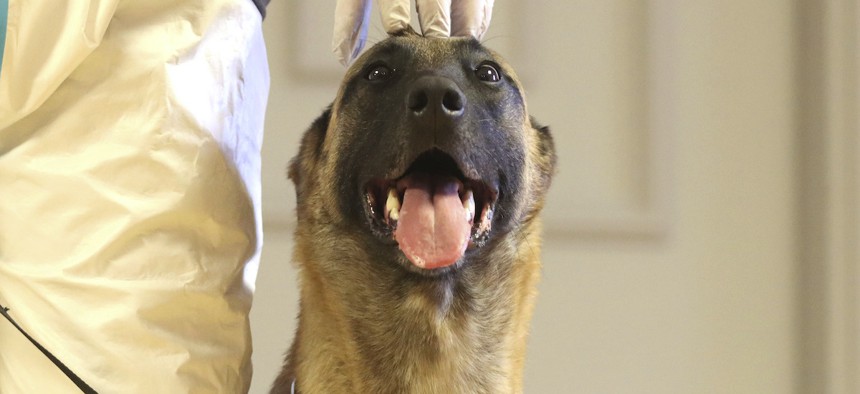The Covid Detection Method That's Been Right Under Our Noses—Literally

Fantasy forever vom Seethalblick, a Belgian shepherd sniffer dog from the Austrian army trained to detect the Covid-19 disease is presented at a press conference in Vienna, Austria, Monday, Dec.14, 2020. (AP Photo/Ronald Zak) Associated Press
Four dogs in Hawaii are training to detect Covid-19 by scent, part of a large international research study to determine whether it's possible—and how it might be used.
In a training facility on the Hawaiian island of Maui, Sadie, Yuki, Samson and Tess are hard at work pioneering a new type of rapid-detection test for Covid-19: sniffing out cases of the virus.
Literally.
The four dogs—one golden retriever (Samson) and three Labrador retrievers (Sadie and Yuki are yellow, Tess is black)—are learning to detect Covid by smell, using sweat samples collected from patients who have tested positive—and negative—for the virus.

It’s a new application of a long-used diagnostic tool that relies on dogs’ superior sense of smell, which allows them to detect volatile organic compounds that are emitted through sweat when a person contracts certain diseases, said Maureen Maurer, executive director of Assistance Dogs of Hawaii, the Maui-based nonprofit training the four dogs.
“We still don’t know exactly what it is that they’re smelling. We just know that they can do it,” she said. “Your dog could smell if someone had an infection, or if they had cancer, but they don’t know how to communicate that information to us, so the training that we do is teaching them how to communicate it.”
The organization primarily trains service dogs for people with limited mobility, including quadriplegics and paraplegics—work that also involves the dogs' sense of smell. Many patients deal with impaired bladder function, which can quickly progress from a simply infection to life-threatening sepsis, Maurer said, so service dogs may be trained to detect those problems before they become serious.
The Covid-19 detection training is similar, Maurer said, and relies on sweat samples, provided by volunteers at the nearby Queen’s Medical Center. The donated samples, collected on fabric, are placed into cups and lined up alongside similar swabs from people who have tested negative for the coronavirus. The dogs go through the lineup, sniff each cup and alert their handler if one is positive for the virus. The training itself is relatively straightforward, Maurer said. Guaranteeing a steady supply of samples is the tricky part.
“While we wait for samples, we just teach them to alert to other target scents, so they’re learning to go through the lineup, ignore the negative samples, find the target and get a reward,” she said. “They learn quickly, so the training is the easy part. The challenging thing is collecting enough samples.”
The organization began looking for volunteers at the end of November and is hoping to collect a minimum of 200 positive and 800 negative samples. The research will contribute to an international study, spearheaded by Medical Detection Dogs UK and the London School of Hygiene and Tropical Medicine, which aims to determine definitively whether dogs can detect Covid-19 by scent.
A growing body of research has already suggested that they can, including a recent study that trained six dogs for a month and found that even the animals with the least amount of training were able to detect positive Covid-19 samples more than 76% of the time. Two dogs that had been previously trained to sniff out cancer, by contrast, were able to point to the positive samples every single time, researchers wrote. Additional studies are underway, and dogs are already being used to detect Covid-19 in airports in several other countries, including Finland, which uses training methods similar to Maurer's.
Airport detection could be particularly useful in Hawaii, where the local economy relies heavily on tourism and has been disproportionately affected by the pandemic. Local agencies, including the police departments in Honolulu and Maui, have expressed interest in Maurer’s training method, and because the protocol is simple—dogs can learn to do it in about a month—she’s hopeful that it can be replicated easily in other places as well.
“The dogs can learn so quickly to alert to a target scent, as long as you have enough samples and they can learn that scent,” she said. “They’re very reliable and efficient, and an inexpensive way to provide additional screening for people at airports, schools, maybe even hospitals—anywhere there are a lot of people moving through. I’m really excited about the potential that this has.”
Kate Elizabeth Queram is a staff correspondent for Route Fifty and is based in Washington, D.C.
NEXT STORY: An Uncertain Future for a Key Missing Persons Program





